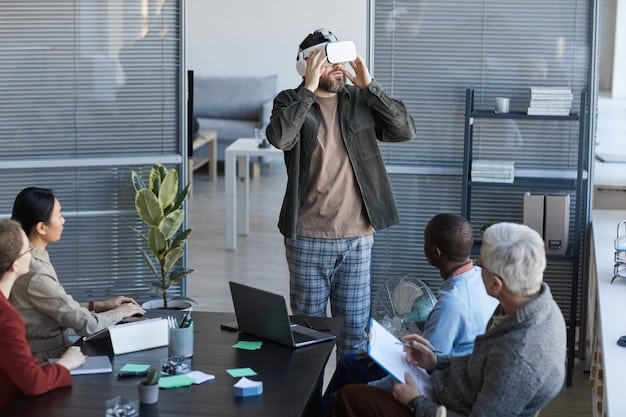AR/VR in Remote Work: Transforming Virtual Meetings by 2025

By 2025, augmented reality (AR) and virtual reality (VR) collaboration tools are poised to revolutionize remote work, transforming virtual meetings into immersive and interactive experiences that enhance communication, engagement, and productivity.
The way we work is constantly evolving, and the future promises even more dramatic shifts. The **future of remote work: How will AR/VR collaboration tools change virtual meetings by 2025?** is a question on many minds as technology continues to advance. Let’s delve into this exciting prospect and explore how these technologies might reshape our virtual interactions.
The Rise of Remote Work and Its Challenges
Remote work has become increasingly prevalent, accelerated by advancements in technology and global events. While offering numerous benefits, it also presents unique challenges that AR/VR aims to address.
Benefits and Drawbacks of Remote Work
Remote work provides flexibility, reduces commuting time, and can improve work-life balance. However, it can also lead to feelings of isolation and difficulties in maintaining team cohesion.
- Increased flexibility and autonomy for employees.
- Reduced operational costs for companies.
- Expanded talent pool due to location independence.
- Challenges in fostering strong team relationships.
The Need for Enhanced Virtual Collaboration
Traditional video conferencing tools often lack the immersive and interactive elements needed for effective collaboration. This is where AR/VR steps in to fill the gap.
The integration of AR and VR technologies into remote work environments promises to enhance collaboration by creating more engaging and realistic virtual interactions. The goal is to replicate the spontaneity and nuanced communication that occur in physical office spaces.

AR/VR Collaboration Tools: Current State and Future Potential
AR and VR technologies are rapidly evolving, with numerous applications already emerging in the business world. By 2025, their capabilities are expected to be even more sophisticated and integrated.
Overview of Existing AR/VR Technologies
Current AR technologies overlay digital information onto the real world, while VR creates completely immersive digital environments. Both technologies have the potential to transform how we collaborate remotely.
- AR applications for real-time data visualization and annotations during meetings.
- VR platforms for creating shared virtual workspaces and simulations.
- Advancements in headset technology, including improved resolution and comfort.
How AR/VR Can Enhance Virtual Meetings
AR/VR can make virtual meetings more engaging and productive by providing a sense of presence and enabling more natural interactions.
The shift from two-dimensional video calls to three-dimensional virtual environments can significantly enhance communication. AR/VR enables participants to share and interact with 3D models, data visualizations, and other digital assets in real-time, fostering a deeper understanding and more collaborative experience.
Impact on Communication and Team Dynamics
The adoption of AR/VR in virtual meetings can have a profound impact on how teams communicate and collaborate, fostering a stronger sense of connection and shared purpose.
Improving Non-Verbal Communication
AR/VR technologies can capture and convey non-verbal cues, such as facial expressions and body language, which are often lost in traditional video conferences. This can lead to more meaningful and empathetic communication.
Mimicking face-to-face interactions through virtual avatars allows team members to read each other’s emotions and intentions more accurately. This improved understanding fosters better rapport and reduces the potential for miscommunication, ultimately leading to more effective teamwork.

Fostering a Sense of Presence and Engagement
By creating immersive virtual environments, AR/VR can foster a greater sense of presence and engagement among participants, leading to more productive and enjoyable meetings.
- Shared virtual spaces that mimic real-world offices or meeting rooms.
- Interactive tools that allow participants to collaborate on projects in real-time.
- Gamified elements that can make meetings more fun and engaging.
Use Cases and Examples in 2025
By 2025, numerous companies are projected to be using AR/VR collaboration tools in various innovative ways to enhance their remote work environments.
Design and Engineering
Design and engineering teams can use AR/VR to collaborate on 3D models and prototypes in real-time, allowing them to identify and resolve design issues more efficiently.
Imagine architects virtually walking through a building design together before construction begins, or engineers collaborating on a complex machine model from different parts of the globe. These use cases offer significant time and cost savings, while also improving the quality of the final product.
Training and Education
AR/VR can provide immersive and interactive training experiences for remote employees, allowing them to develop new skills and knowledge more effectively.
- Virtual simulations of real-world scenarios for hands-on training.
- Personalized learning experiences tailored to individual needs and learning styles.
- On-demand access to training materials and resources.
Virtual Events and Conferences
AR/VR can transform virtual events and conferences into more engaging and immersive experiences, allowing attendees to network and interact with each other in new and innovative ways.
In 2025, attending a virtual conference could mean donning a VR headset and stepping into a bustling virtual expo floor, complete with interactive booths, live presentations, and networking opportunities. This type of experience goes far beyond traditional webinars, creating a sense of community and excitement.
Challenges and Considerations for Adoption
While the potential benefits of AR/VR collaboration tools are significant, there are also challenges and considerations that organizations need to address before adopting these technologies.
Cost and Accessibility
The cost of AR/VR hardware and software can be a barrier for some organizations, particularly smaller businesses. Accessibility is also a concern, as not all employees may have access to the necessary equipment or internet bandwidth.
However, as technology advances, prices are expected to decrease and accessibility to improve. Widespread adoption may require subsidized programs or shared resource initiatives to make AR/VR technology more inclusive.
Technical Infrastructure
Implementing AR/VR collaboration tools requires a robust technical infrastructure, including high-speed internet access and powerful computing devices. Organizations may need to invest in upgrades to their existing IT infrastructure.
- Ensuring seamless integration with existing communication and collaboration platforms.
- Providing technical support and training to employees.
- Addressing security and privacy concerns related to data transmission and storage.
User Experience and Comfort
The user experience is critical to the successful adoption of AR/VR technologies. Headsets need to be comfortable to wear for extended periods, and the virtual environment needs to be intuitive and easy to navigate.
Manufacturers are continuously improving headset designs to be lighter, more ergonomic, and more user-friendly. Software developers are also focused on creating more intuitive and accessible AR/VR interfaces to enhance the user experience.
Preparing for the Future of Remote Work with AR/VR
As AR/VR technology continues to evolve, organizations need to start preparing for the future of remote work by exploring the potential applications of these tools and developing a strategic plan for adoption.
Investing in Research and Development
Organizations should invest in research and development to identify the best AR/VR solutions for their specific needs and to stay ahead of the curve in this rapidly evolving field.
This includes partnering with AR/VR technology providers, participating in industry events, and conducting pilot projects to test the feasibility and effectiveness of different solutions. By investing in R&D, organizations can gain a competitive advantage and position themselves for success in the future of remote work.
Training and Education Programs
Organizations should provide training and education programs to help employees develop the skills and knowledge they need to use AR/VR collaboration tools effectively.
- Basic training on how to use AR/VR hardware and software.
- Advanced training on how to leverage AR/VR for specific tasks and workflows.
- Ongoing support and resources to help employees stay up-to-date on the latest developments.
Building a Collaborative Culture
Ultimately, the success of AR/VR collaboration tools depends on building a collaborative culture that encourages experimentation, innovation, and knowledge sharing. Organizations need to create an environment where employees feel empowered to explore new technologies and find new ways to work together.
| Key Point | Brief Description |
|---|---|
| 🚀 Immersive Meetings | AR/VR enhances virtual meetings with immersive 3D environments. |
| 🤝 Enhanced Communication | Non-verbal cues are captured, fostering better team communication. |
| 🛠️ Use Cases | Design, training, and virtual events are transformed by AR/VR. |
| 🚧 Challenges | Costs, technical infrastructure, and user experience need consideration. |
FAQ
▼
By 2025, AR/VR is expected to revolutionize remote work, transforming virtual meetings into immersive, interactive experiences. This includes enhancing communication, engagement, and overall productivity through virtual presence.
▼
The main benefits include improved non-verbal communication, increased engagement and a stronger sense of presence among participants. AR/VR also enables real-time collaboration on 3D models and data, leading to better understanding.
▼
Challenges include the cost of AR/VR hardware and software, technical infrastructure requirements, accessibility issues, and ensuring user comfort during extended use. Addressing security and privacy concerns is also essential.
▼
Industries such as design and engineering, training and education, and event management can benefit greatly. AR/VR enables virtual prototyping, immersive training simulations, and engaging virtual conferences, improving efficiency and outcomes.
▼
Companies should invest in research and development, and training programs for employees. Also, it’s important to build a collaborative culture that embraces new technologies. Addressing the technological needs will ensure seamless integration.
Conclusion
The **future of remote work** is undeniably intertwined with the advancements in AR/VR technology. By 2025, we can expect to see a significant shift in how virtual meetings are conducted, with AR/VR collaboration tools playing a central role in enhancing communication, engagement, and productivity. While challenges remain, the potential benefits are too significant to ignore. Organizations that embrace these technologies will be well-positioned to thrive in the evolving landscape of remote work.





